Iyadani-ji
The Iyadani-ji ( Japanese 弥 谷 寺 ) with the Go Kengozan (剣 五 山) and Sentein (千手 院) is a temple of the Shingon direction of Buddhism, high on the slope of the 382 m high Iyadani Mountain (弥 谷 山, Iyadaniyama) located in Mitoyo ( Kagawa Prefecture ). In the traditional count, it is the 71st temple on the Shikoku pilgrimage route .
history
At the request of the emperor Shōmu , priest Gyōki is said to have created a small temple complex, which was then expanded in memory of the parents of the empress Kōmyō (光明 皇后, Kōmyō-kōgō; 701-760). In any case, the temple has scriptures that must have been written in the year 724, so that it must be at least as old, if not older.
The Iyadani Mountain as a whole has long been considered the seat of the deceased, and Shingon Buddhism sees it that way too. Therefore one makes a pilgrimage to him to commemorate the dead.
investment
In front of the temple gate (仁王 門, Niō-mon; 1) there is the haiku tea house (俳 句 茶屋, Haiku Chaya; T), which can still be reached by car. This is followed by long, not very steep stone stairs. The pilgrimage along the stream to the Hōun Bridge (法 雲 橋) is called the "field of sacrifice" (賽 の 河 原, Sai no kawahara). It is lined with numerous stone Jizo figures. Then it goes over a very steep iron staircase with 108 steps (百八 階段, Hyakuhachi Kaidan; 3) up to the memorial hall for the temple founder, the Daishidō (大師 堂). Behind the hall is the “lion's den” (獅子 窟, Shishikutsu). On the three sides of the mandala pedestal stand the Amida Buddha, the Dainichi Buddha and the holy Jizō, as a representation of the Buddha carved into natural rock. If one prays there, all sins will be destroyed by the lion.
After the Daishidō you can see the treasure pagoda (多 宝塔, Tahōtō), the “Hall of the Ten Kings” (十 王 堂, Jūōdō), the bell tower (鐘楼, Shōrō) and also the Hikuni valley (比丘尼 谷). Countless Gorintō and two- or three-story pagodas are carved into the rock walls there . The hair or bones of a deceased used to be buried there. If you climb the stone stairs in front of the bell tower , you come to the "Bitthöhle" (求 聞 待 窟, Kumonjikutsu), in which there is a stone figure of Dōhan Ajari. Another staircase leads to the main hall (本 堂, Hondō; 2), which is built on a rock wall. - You can climb further up and then have a beautiful view of the Sanuki plain.
There are numerous graves on the temple grounds, mainly from the Edo period . The stone stupa of Yamazaki Toshiie (山崎 俊 家; 1617–1651), a chief of the Yamazaki clan based in Marugame, and that of Kagawa Nobukage (香 川 信 景), who owned Amagiri Castle (天 霧 城) - it was abandoned in 1585 - owned are particularly well known.
Treasures
The temple's treasures include the “Kondō Gokorei” (金銅 五 鈷 鈴), an ensemble of five gilded bronze bells. They come from the Tang period and are registered as an important cultural asset of Japan .
photos
Remarks
- ↑ A microbus goes up a little further on a different route, to point B in the plan.
- ↑ The number 108 has a special meaning in Buddhism, even if the exact derivation is unclear. The temple bells are struck 108 times for the New Year.
- ↑ Dōhan Ajari (道 範 阿闍梨), who came from the province of Izumi , was so busy reading Buddhist texts that he forgot to eat, starved, but lived on spiritualized. He is revered in esoteric Buddhism.
literature
- Kagawa-ken no rekishisampo henshu iinkai (Ed.): Iyadani-ji . In: Kagawa-ken no rekishi sampo. Yamakawa Shuppan, 2013. ISBN 978-4-634-24637-9 . Page 227.
Web links
Coordinates: 34 ° 13 ′ 47 " N , 133 ° 43 ′ 27.3" E
← Previous Temple: Motoyama-ji | Iyadani-ji | Next temple: Mandara-ji (Zentsūji) →








